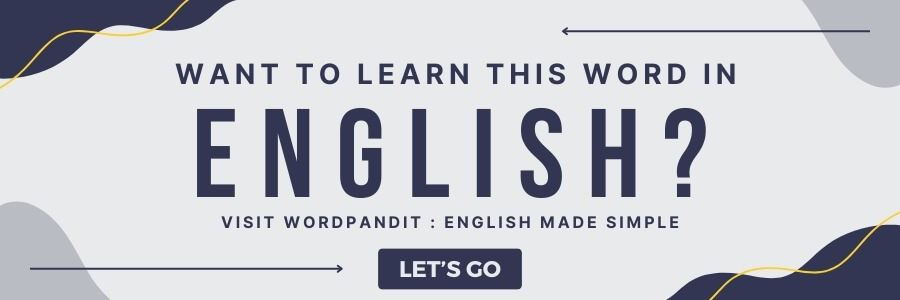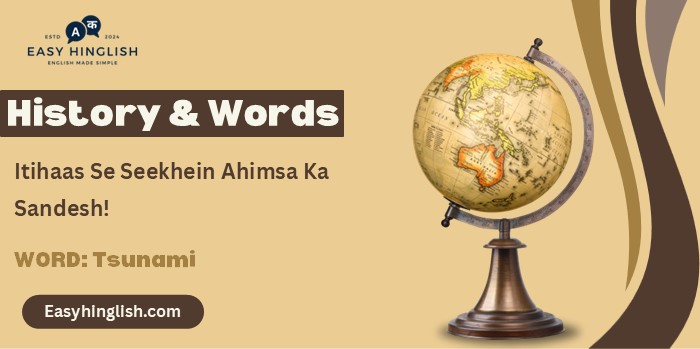History & Words: 'Tsunami' (December 26)
Welcome to 'History & Words.' Main Prashant hoon, Wordpandit aur Learning Inc. Network ka sansthapak. Yeh series meri bhasha seekhne ki lagan aur itihas ke prati ruchi ka sangam hai. Har kadi ek shabd aur uss se judi ek tithi par roshni daalti hai, jisse aapka shabdkosh badhta hai aur aap itihas ko gehraai se samajh paate hain. Aaiye, iss safar mein shabdon ke madhyam se samay mein pichhe chalein.
🔍 Word of the Day: Tsunami
Pronunciation: /tsuːˈnɑːmi/ (tsoo-NAH-mee)
🌍 Parichay (Introduction)
26 December 2004 ko ek 9.1 magnitude ka earthquake Indian Ocean mein aya aur usne history ki sabse deadliest tsunamis mein se ek trigger kiya. Is natural disaster ne 2,30,000+ lives claim kiin aur 14 countries ko affect kiya. Yeh moment global tsunami awareness aur warning systems ka turning point maana jaata hai.
Tsunami sirf ek Japanese word nahi – yeh ocean ki raw power ka symbol hai jo minutes mein entire coastlines ko devastate kar sakti hai. Is disaster ke baad International cooperation, early warning systems, aur disaster preparedness ke concepts completely revolutionize ho gaye.
Aaj hum jaante hain ki Pacific Tsunami Warning Center se lekar local evacuation protocols tak, sabka foundation 26 December 2004 ke tragic lessons par based hai. Yeh day humein sikhaata hai ki nature ki power ke saamne human preparedness kitni important hai.
🌱 Shabd ka Utpatti (Etymology)
"Tsunami" Japanese language ka word hai jo "tsu" (harbor) + "nami" (wave) se bana hai, matlab "harbor wave." Yeh term 1850s mein scientific literature mein enter hua, lekin global vocabulary mein properly 2004 disaster ke baad establish hua.
Originally Japanese fishermen yeh word use karte the kyunki jab woh sea mein fishing karte the, unhe open ocean mein koi unusual wave nahi dikhti thi. Lekin jab woh harbor wapas aate the, tab devastating waves unhe milti thin. Hence, "harbor wave."
Western scientific community initially "seismic sea wave" ya "tidal wave" terms use karti thi, lekin "tsunami" zyada accurate hai kyunki yeh tides se bilkul related nahi hota.
📖 Mahatvapurn Shabdavali (Key Vocabulary)
- 🔑 Megathrust Earthquake: Massive earthquake caused by tectonic plate subduction
- 🔑 Seismograph: Instrument that detects and records earthquakes
- 🔑 Epicenter: Point on Earth's surface directly above earthquake's focus
- 🔑 Inundation: Flooding of normally dry land by tsunami waves
- 🔑 Early Warning System: Technology network for disaster alerts
- 🔑 Subduction Zone: Area where one tectonic plate slides under another
🏛️ Itihasik Sandarbh (Historical Context)
Tsunamis ka recorded history thousands of years purana hai. Ancient Greece, Japan, aur Mediterranean regions mein devastating tsunamis ke accounts milte hain. Minoan civilization ka decline bhi possibly Santorini volcanic tsunami ki wajah se hua tha around 1600 BCE.
Japan mein tsunamis regular natural hazard consider hoti hain. 1896 ka Meiji-Sanriku tsunami ne 22,000 lives claim kiin. Historical Japanese records mein hundreds of tsunami events documented hain, isliye yeh Japanese vocabulary ka integral part hai.
Pacific Ring of Fire region mein frequent seismic activity ki wajah se Pacific Tsunami Warning Center 1949 mein establish hua, lekin yeh mainly Pacific Ocean ko cover karta tha. Indian Ocean mein comprehensive warning system 2004 se pehle exist nahi karta tha.
Scientific understanding gradually develop hui. 19th aur 20th century mein seismology as a field emerge hua, aur plate tectonics theory ne tsunami generation mechanism ko explain kiya.

⏳ Samayrekha (Timeline)
- 1755 – Lisbon earthquake and tsunami kills 60,000+ in Portugal
- 1896 – Meiji-Sanriku tsunami devastates Japan's coast
- 1946 – Aleutian tsunami leads to creation of Pacific Warning Center
- 1960 – Chilean tsunami affects Pacific rim countries
- 1964 – Alaska earthquake generates destructive tsunami
- 1993 – Hokkaido tsunami in Japan kills 200+
- 26 Dec 2004 – Indian Ocean tsunami - deadliest in recorded history
- 2005-2006 – Indian Ocean Tsunami Warning System established
- 2011 – Tōhoku tsunami in Japan, Fukushima nuclear disaster
🌟 Is Din ka Mahatva (The Day's Significance)
26 December 2004 ki subah 7:58 AM local time par Sumatra ke paas 9.1 magnitude earthquake aya – 40+ years mein sabse powerful. Yeh Indo-Australian aur Burma tectonic plates ke beech massive rupture ki wajah se hua, jo 1,600 kilometers long fault line par extend karta tha.
Tsunami waves ka first set 15 minutes mein northern Sumatra ko hit kiya. Thailand, Sri Lanka, India, Maldives tak waves 2-8 hours mein pahunchi. Wave heights 30 meters tak record hui kuch areas mein. Banda Aceh mein entire districts wipe out ho gaye.
International response unprecedented tha. $14 billion+ aid pledge kiya gaya. UN coordination, military deployments, medical teams – sabne massive relief operation launch kiya. Media coverage bhi 24/7 global attention ensure karta raha.
Scientific community ko realize hua ki Indian Ocean mein tsunami warning system ki urgent need hai. Pacific mein sophisticated network exist karta tha, lekin Indian Ocean completely unprotected tha. Tourism industry, coastal development, local communities – sabke liye yeh wake-up call tha.
💬 Prasiddh Ukti (Quote)
"The sea, once it casts its spell, holds one in its net of wonder forever." — Jacques Cousteau
🔮 Aaj Ka Matlab aur Chintan (Modern Usage and Reflection)
Aaj "tsunami" word literal ocean waves se beyond use hota hai. Economic tsunami, data tsunami, emotional tsunami – metaphorical usage common ho gaya hai overwhelming situations describe karne ke liye.
Scientific community mein tsunami science ab mature field hai. Computer modeling, satellite monitoring, deep-ocean detection buoys se prediction accuracy dramatically improve hui hai. Social media aur mobile technology ne early warning dissemination ko revolutionize kar diya hai.
🏛️ Virast (Legacy)
2004 tsunami ki sabse badi legacy Indian Ocean Tsunami Warning System hai jo 2006 mein operational hua. UNESCO's Intergovernmental Oceanographic Commission manage karta hai yeh system jo 28 countries ko cover karta hai.
Building codes, coastal planning, community preparedness – sabmein tsunami considerations integrate ho gaye hain. "Tsunami-ready communities" concept develop hua hai jisme education, evacuation routes, aur regular drills include hain.
🔍 Tulnatmak Vishleshan (Comparative Analysis)
2004 se pehle tsunami regional hazard consider hoti thi, mainly Pacific region mein. Post-2004, yeh global concern ban gayi. Warning systems pehle country-specific the, ab international cooperation standard hai.
Traditional knowledge vs modern technology ka balance bhi important lesson tha. Indigenous communities jo natural signs recognise karte the, woh modern early warning se combine hokar more effective preparedness create kar sakte hain.
💡 Kya Aapko Pata Hai? (Did You Know?)
🎓 Antim Vichar (Conclusion)
Tsunami ne humein sikhaaya ki nature ki power ke saamne human vulnerability kitni real hai, lekin international cooperation aur scientific advancement se disaster impact ko minimize kiya ja sakta hai. 26 December 2004 ka tragic day global tsunami preparedness ka foundation ban gaya.
Aaj bhi har coastal warning siren, evacuation sign, aur deep-ocean buoy mein 2004 ke victims ki memory chhipi hoti hai – ek aisi memory jo future disasters se bachane ke liye constant vigilance ka reminder hai.
📚 Aage Padhne Ke Liye (Further Reading)
- 📘 The Wave: In Pursuit of the Rogues, Freaks, and Giants of the Ocean – Susan Casey
- 📗 Tsunami: The Underrated Hazard – Edward Bryant
- 📙 The Next Tsunami: Living on a Restless Coast – Bonnie Henderson








